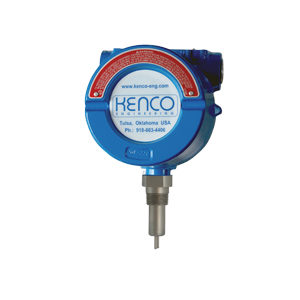Thermal Differential Level & Flow Switches
KENCO’s Thermal Differential Switches are designed for a wide range of flow and level applications. These switches can be used to direct either the overall liquid level or a liquid-liquid interface. They can also be used to detect a specific flow rate or flow/no flow condition in liquids and gasses.
Principle of Operation
The sensor consists of two Resistance Temperature Detectors (RTD’s). One RTD measures the temperature of the fluid around the sensor. The other RTD is self-heated. This provides a temperature differential between the the two RTDs. In a level application, the thermal conductivity of the liquid level is higher than the gaseous layer above the liquid. When the RTDs make contact with the liquid, there is a cooling effect with the liquid absorbing the heat from the heated RTD. This reduces the temperature differential increases, causing the relay to reset. This will also work in a liquid-liquid interface when the two liquids have different thermal conductivity (ex. oil and water). In a flow application, there is a temperature differential during a no-flow or low-flow condition (the actual setpoint is adjusted during the calibration procedure). As the flow rate increases, the temperature between the RTDs decreases, causing the relay to change state. When the flow rate decreases, the temperature differential increases, causing the relay to reset.
Features
- Level and Interface Detection
- Flow Detection for Liquids and Gasses
- Fast Response Time
- No Moving Parts
- Temperature Compensation
Benefits of Ownership
- Application Flexibility
- Better Process Control
- Reliability
- Stability And Repeatability
Applications
- Level Detection
- Nitrogen Flow Detection
- Low Flow Monitoring
- Liquid-Liquid Interface Detection
- Foam-Liquid Interface Detection
- Pump Protection
- Flare Systems
Industries
- Chemical
- Petroleum
- Water/Wastewater
- Pharmaceutical
- Pulp & Paper
- Power
- Aerospace
Specifications
Models
- KTDL = Level Switch
- KTDF = Flow Switch
Connections
- Process Connection Options =
– 050: ½” NPT
– 075: ¾” NPT
– 100: 1″ NPT
– 3A1: 1½” Sanitary
– RA1: 1″ 150# ANSI Flange
– RA2 : 2″ 150# ANSI Flange
– RB1: 1″ 300# ANSI Flange
– RB2: 2″ 300# ANSI Flange
– LFS: Low Flow Sensor
– SPL: Special Connection - Electrical Connections = 3/4″ FNPT
Sensor Materials
- S6 = 316L SS
- S4 = 304 SS
- SL = 304L
- HB = Hastelloy-B
- HC = Hastelloy-C
- IO = Inconel 600
- MN = Monel
- A2 = Alloy-20
- SM = Special Material
Insertion Length (Inches)
- 002.00 (standard)
- 002.50 – 120.00 (optional)
Input Power
- 110 = 110Vac
- 220 = 220Vac
- 24D = 24Vdc
- 24A = 24Vac
Configuration
- LE = Integral Mounting
- RE = Remote Mounting
Additional Options
- 00 = No Options
- RT = RTD Output
- LT = Live Tap
- CE = CE Approved
- EN = Extended Neck
- HT = *High Temp (850°F)
- MT = *Medium Temp (572°F)
- XW = Explosion-proof Window
- CA = Additional Cable
- VI = Variable Insertion
- CB = Factory Calibration
- TO = Thermocouple Output
- TG = SS Tag
- TE = Sensor Installed in Tee
Power Supply
- AC = 110Vac or 220Vac @ 50/60 Hz
- DC = 24Vdc
Output
- Relay = 5A DPDT – Failsafe is field selectable
Temperature Range (Electronics)
- -40°F to 140°F (-40°C to 60°C)
Temperature Range (Sensor)
- Standard = -100°F to 390°F (-70°C to 200°C)
- Medium Temp. = -100°F to 572°F (-40°C to 300°C)
- High Temp. = -100°F to 850°F (-40°C to 458°C)
Pressure Range
- Atmosphere to 3000 psig (206.84 bar)
Operating Range (Flow)
- Aqueous Liquids = 0.01 to 2.5 feet/second
- Hydrocarbon Liquids = 0.01 to 5.0 feet/second
- Gasses = 0.1 to 500 feet/second
Response Time
- 0.5 to 5.0 seconds (media dependent)
Stability
- <0.5% from calibrated setpoint over a range of ±50°F
Repeatability
- ±1.0%

